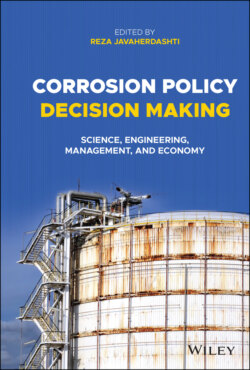Читать книгу Corrosion Policy Decision Making - Группа авторов - Страница 39
Notes
Оглавление1 * https://www.linkedin.com/in/dr-reza-javaherdashti-9a2a2415.
2 † .https://www.linkedin.com/in/ali-ghanbarzadeh-a5abba55
3 1 Examples in this regards can be that oxidation implies that oxygen is involved or must be involved in the corrosion process. While for many cases it is true, for an even larger number this may not necessarily be taken as a true statement (take, for example, MIC by anaerobic sulfate reducing bacteria). Therefore, it is always better to address electrons giving off reactions as “anodic reactions.” In addition, “corrosion under deposit” does not say anything about the corrosion mechanism(s) involved, it just indicates where corrosion is taking place, which is, of course, under deposits. If the involved corrosion mechanism(s) are not specified, mere use of “under deposit corrosion” is a useless, pseudo‐professional statement. Dissimilar metal corrosion is yet another technically wrong expression; this corrosion process that is correctly referred to as “galvanic corrosion” can happen on the same metals but with different conditions that will make their electrochemical properties become different. Welding a new pipe of smaller surface area (length) to the same size of the same pipe material that has been already in use for some time makes the former become anodic to the latter as the old pipe could actually act as a cathode, due to factors such as being covered with a layer of rust. Thus, never replace the right term “galvanic corrosion” with the wrong term “dissimilar metal corrosion.” Biofilm implies a film that has a totally biological fabric. Both implications are incorrect; biofilm is neither a film nor is 100% biological. In our publications, we have proposed another term which is “temenos” to compensate for these misunderstandings and faults.
4 2 In some sources, the reasons put forward for the rejection and creation of problems in of Purbaix's PhD thesis and graduation are described as “The war and some confusion among the jury on the sign of electrode potential.”
5 3 Engineering Encyclopedia, Saudi Aramco DeskTop Standards, entitled “MATERIALS OF CONSTRUCTION FOR PRESSURE VESSELS” considers corrosion allowance an important measure to control corrosion. On page 6 of this Desktop standard it reads verbatim “The most common method that is used to address corrosion in pressure vessels is to specify a corrosion allowance.” While corrosion allowance is certainly not a corrosion treatment measure in the way that, for example, physical, chemical, or electrical treatment measure are, and despite that corrosion allowance is used in limited industries, it cannot be denied that these industries are themselves of appreciable importance to all industry sectors.
